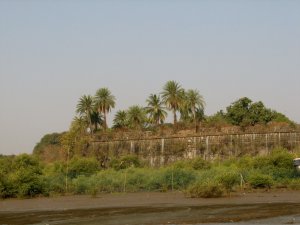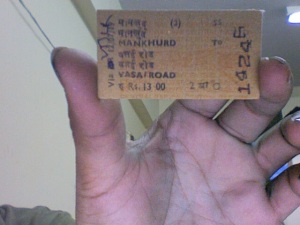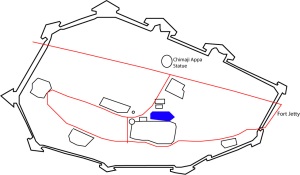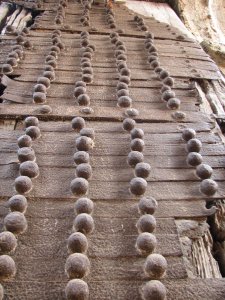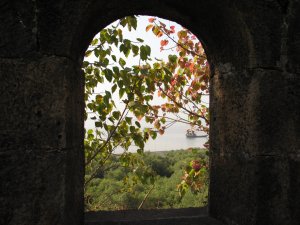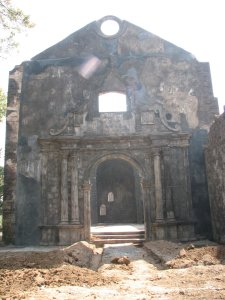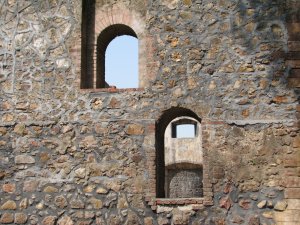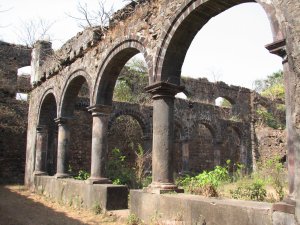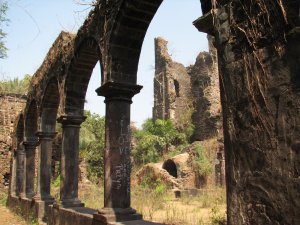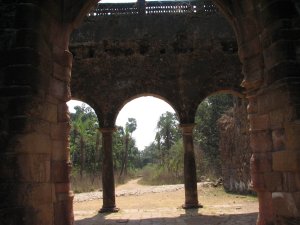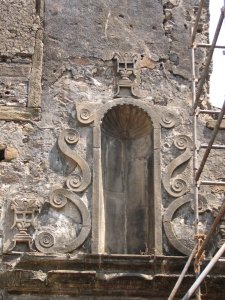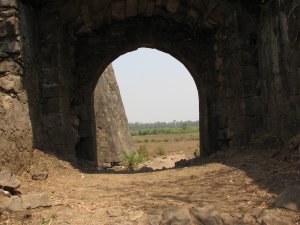This is an interesting account of Nagpur state from late eighteenth century. It is part of a small book titled Journal Of A Route To Nagpore by Daniel Robinson Leckie. I have taken some liberty to replace the long s typeset as f with regular s. For example, coft is cost. Some of the names are in archaic English but one can make sense of the them. For example Peshwa is Paishwah. This account shows the extent of the Rajah of Nagpore’s territories as well as some peculiarities of the region. Some of the places that are mentioned are the fortifications, palace, Jumma Talao, Sakkardarah etc. The account also has a short, somewhat incorrect, history of the house of the Bhoslas. Leckie says the Nagpur Bhoslas were descended from Shivaji’s house which clearly was not the case. Also there are remarks on the current affairs of the Nagpur state with the Peshwa in Pune and Chatrapati in Satara.

ACCOUNT OF NAGPORE,
&c. &c.
NAGPORE, situated in 79º 46′ east longitude from Greenwich, and 21º 49′ north latitude, is the present capital of Gondwauna1, a name little known to Europeans, perhaps owing to the remote situation of it from our settlements, and the Rauj2 of that name having been dismembered before we possessed any territory in India, at which time the comparatively confined state of the affairs of the Company did not lead to geographical inquiries.
I have taken no small degree of pains to ascertain the boundaries of Gondwauna; and though I will not pretend to say that the information I have procured is in every respect: exact, yet it may serve to give a general idea of the extent of the country.
It is not amiss to observe, that the people of this place are by no means communicative, and very circumspedt in giving information, particularly to Europeans, and it has cost me no small degree of trouble to collect what trifling information this account contains.
Gondwauna is bounded on the north-east; by an imaginary line, drawn from the town of Belhare to the city of Ruttunpoor; on the south-east by such another imaginary line, drawn from Ruttunpoor through the village of Soormul (situated about five coss to the north-east of Nurrah, which last is laid down in the map), to the junction of the Oordah and Beingunga rivers; on the south-wedt by the Oordah (Wadha) river; and pn the north-east by that chain of mountains which separates it from Malwa.
When Gondwauna was partly reduced by Aulumgwer, he obliged a great number of the natives together with the Rajah, to embrace the Mahomedan religion ; and the country remained for a series of years in this situation, the Rajah paying a fort of homage to the Moghul, as lord paramount : when, in the beginning of the present century, Ragojee Bhooshla, descended from the great Sevagi, reduced the greatest part of Gondwauna, to the south of the Nurbudda, with the province of Berar. The lenity with which he treated the Gonde Rajah deserves particular mention, as it shows a trait of humanity in the Merhattahs worthy of the highest pitch of civilization. He not only abstained from all forts of personal violence, but allotted three lachs of rupees annually for the Gonde Rajah’s maintenance, and the fort for him to live in, by no means as a confinement. Burhaun Shah, the son of the conquered Rajah, has still handsome allowances, and the fort to live in ; and the confidence which the late Moodajee placed in him was great: for what could be a greater mark of it in the East, than putting his family and women under his charge when he went upon any warlike expedition? which he constantly did.
Ragojee was the founder of Nagpore, which he surrounded with a rampart, it being only an insignificant village appertaining to the fort prior to his capture of it. It is situated oh a high plain, is richly cultivated, and produces fine wheat, and bounded by hills to the north- west and south. The Nag Nudde, a rivulet running to the southward, gives name to the town.
The houses are generally meanly built and covered with tiles, and the streets are narrow and filthy. The only good building is the palace, begun by the late Moodajee, and now finishing by his fon, the present Rajah ; it is built of a blue done dug out of a quarry in large blocks on the western skirts of the town. The present Rajah, however, has destroyed the grand effect which would have been produced by the stone alone, by intermixing brick-work in the building. There is a very large and deep3 tank near the west gate, called Jumma Tallow, three sides of which are handsomely built up with masonry ; and the Rajah has a foundery to the southward of the town, called Shukerderri, where he calls tolerably good brass guns. There, with some few gardens of the Rajah’s, neatly laid out in walks planted with cypress-trees, and interspersed with fountains, are the only places of note at Nagpore.
It should appear that Major Rennell (Memoir, second edition, 4to. page 12) is not perfectly clear with regard to the idea he has formed of the Merhattah state, that all the chiefs owe a fort of obedience to the Paishwah, resembling that of the German Princes to the Emperor. The account I heard from the Dewaun4 in the Durbar5 was,
But the fine extensive country which the Paishwah occupies, together with the advantage of playing the Sattarah puppet, will always give him influence with the other chiefs.
“That there is a person whom they call the representative of the Rauj, who is kept in the fort of Sattarah, and he is treated with all imaginable respect when he makes his appearance at Poonah, which is only upon particular occassions ; and when at Sattarah he is supplied with every luxury, and magnificently attended. On the demise of this image of government the handsome son of some poor man is chosen to supply his room. The Paishwah is prime minister to the Merhattah state; the Rajah of Nagpore, &c. commander in chief of the armies ; and they, as well as the rest of the chiefs, call themselves. servants of the Rauj; and none acknowledges the least immediate authority of the Paishwah, but they are all bound in cafes of necessity to render mutual assistance to each other, for the public good of the constitution.’’
The present Rajah, Rogojee Bhooshla, the grandson of the Conqueror (Ragojee the first was succeeded by his eldest son, Jannojee who was succeeded by his brother Sabage, who was slain in battle by Moodajee, the father of the. present Rajah. I have not the particulars their histories) does not seem to be either adapted to civil or military business ; he is generally dressed plainly in white, but wears costly diamonds and pearls; his behaviour is courteous to strangers. His great penchant is for elephants and mares. He has about 200 of the former, the finest; I ever beheld; and they are fed so sumptuously with sugar-cane, treacle, ghee, &c.. and not unfrequently fowl pallow, that they become almost mad with lust, breaking their chains and doing great mischief, which is considered by the Merhattahs as fine sport. The principal people about the Rajah are, his brother, Munnea Bapoo, a very quiet young man; Bhowaunny Caulloo, the Dewaun, a shrewd old fellow, and his nephew, Pondrang, the commander and paymaster of the army; Siree Dhur, the Monshee; and Mahadajee Leshkery, the Rajah’s confident, who is consulted on all occasions.
The Rajah does not keep up above 10,000 horse, the pay of which, as is the custom among all native princes, is irregularly distributed. He has two battalions of Sepoys, armed and clothed like ours ; and although they have been drilled by black officers, formerly belonging either to the Nabob of Lucknow, or our service, yet they go through their exercise very badly, and I do not think they will be able to make a stand against any body of native Sepoys disciplined by European officers.
I have heard that the total collections of the Rajah’s dominions, including Ruttunpore and Cuttae, only amount to seventy lacks of rupees per annum. I will not, however, pretend to affirm that this is exact though I do not think it can much exceed that sum; for the Rajah’s country, notwithstanding the great extent of it, does not contain a proportionable quantity of cultivated land to that which is waste and occupied by forests.
It is generally supposed that Nagpore is the capital of Berar. This is evidently a mistake. The inhabitants of Nagpore talk relatively of Berar as an adjoining province, as we do of Bahar to Bengal; and it has been shown that Nagpore is a city of late date. Elichpour is the capital of Berar, by the accounts I have received from the natives, who represent it as a very ancient city, and much larger than Nagpore.
A custom prevails in this town, which I cannot forbear taking notice of, because it serves to prove that long usage will give a plausibility to things seemingly the most preposterous. The bramins and best people at Nagpore have women attendants upon their families, whom they breed up from their childhood, and are called Butkies, or Slauls. They attend on their masters and mistresses during the day-time, and are permitted to go to any man they please in the night; some of them become very rich, and they are in general very handsome, fine women.
Nagpore,
August 20, 1790.
(Daniel Robinson Leckie)
1The three ancient capitals of Gondwauna were Gurry Mudlah, Gurry *****, and Deogur.
2The dominion of a Raujah is called a Rauj, that of a King is denominated a kingdom.
3Pond
4Minister
5Court


